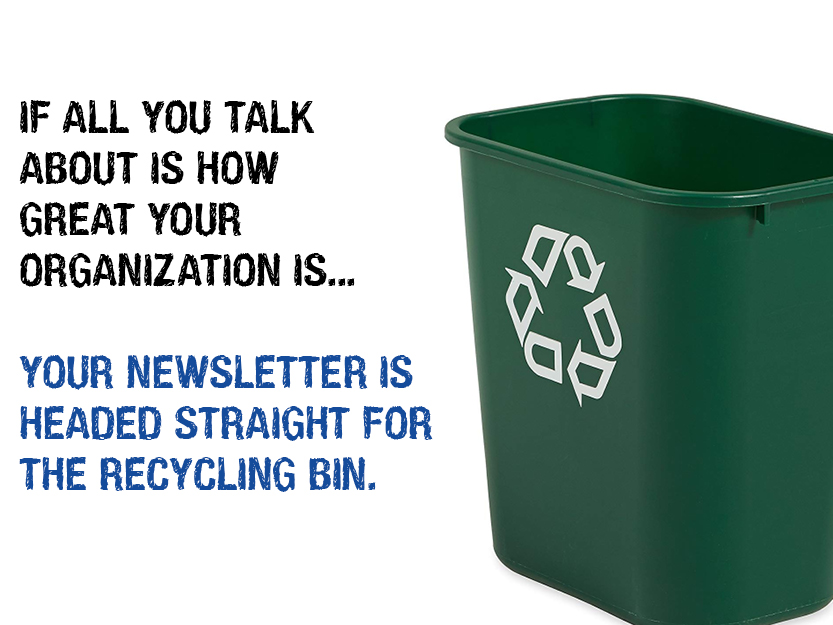Here’s a little reality check about what your newsletter is not for…
- It’s not for talking about how great your organization is.
- It’s not for writing about the new staff you just hired or the award your board chair just got.
- It’s not for your executive director to write a letter on the state of the world.
If you’re doing any of these things, stop. Please.
Content like that inspires tossing your newsletter directly into the recycling.
Your newsletter is your opportunity to tell your supporters how they made the world a better place by donating to you. It’s where you report back on how their support made a difference.
Your newsletter should give your donors an up-close view of their gifts at work. It’s where you thank them for everything they made possible.
Are you telling your donors about all the great things your organization did, or are you telling them about all the great things they did because they gave to you?
The answer is the difference between good newsletters and newsletters that, to put it bluntly, suck.
So, what should go in your newsletter?
News!
It’s not a coincidence that the first part of NEWSletter is the word “news.” And the most compelling news should go on the front page. (Hint—it’s not the letter from the ED. The NY Times isn’t running letters from their publisher or CEO on the front page. Neither should you. I recommend not doing them at all.)
What else should be banished from your newsletter? Bios of new staff, stories about your annual employee picnic, an award one of your board members received…this isn’t what your donors care about.
Donors want to know four things…what you accomplished with their money (success stories and impact), what you’d do if they gave you more money (previews of coming attractions), that they matter and their support makes a difference (credit and appreciation), and what you’re spending their money on (transparency and accountability).
That’s what is interesting to your readers. That’s news. [PDF]
Donor Love
You’ve got to give your donors credit for your achievements. And not just with an obligatory, “Thank you for your support” at the end.
Your newsletter is not about what your organization accomplished. It’s about what your donors accomplished through your organization. You want them to know they made a difference. Give them credit for each and every success you’re writing about.
Shower your donors with gratitude and appreciation. Without them, none of your work would be possible. [PDF] With them, look at what you can do. That should be the tone of your whole newsletter.
The Word “YOU”
Without using the word “you,” you are not talking to your donors. The word “you” is the only way to address people directly and get their attention without using their proper name.
Do what Tom Ahern first told me to do—read your newsletter and circle the word “you” in a bright color every time you see it. Your pages should be covered with circles! If not, start rewriting until the word “you” is everywhere. And, no—”we” isn’t good enough. “We” means your organization (you as the writer and the rest of your staff). “We” doesn’t mean you and your donor. It’s “you” and nothing else. There is no substitute for you.
Stories
Use stories to demonstrate impact, not lots of statistics. The story of one person is more memorable and has more impact than a bunch of numbers. [PDF]
Numbers are overwhelming, especially numbers painting the problem as so big that one person couldn’t possibly make a dent in solving it. Stories paint a picture, put us at the scene, tap our emotions. You must make your readers feel something—fear, hope, anger, guilt, compassion. They don’t have to be good, warm, fuzzy feelings. Just make them feel something!
And, please, no jargon. Save the nonprofit-ese for the grant proposals, if you must use it. Write your newsletter so it sounds like it was written by a human being. (Though, frankly, I prefer my grant proposals to be written by a human being too, but that’s another issue.)
So, there you have it…Now go create an inspiring, revenue-generating, relationship-building newsletter that your donors wouldn’t dream of tossing in the recycling.



